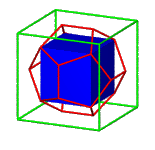
The Golden Section
The Golden Triangle
The Regular Pentagon and the Pentagram
The Dodecahedron
The Golden Section

The starting point is the division of a line segment in mean and extreme ratio.
A point on a line segment divides this segment in mean and extreme ratio if the ratio of the
whole segment to one part is the same as the ratio of that part to the remaining part of the line segment.
Given a line segment AB, the point P divides AB in mean and extreme ratio if

A special isosceles triangle or "golden triangle"

We consider an isosceles triangle with a top angle measuring 36 degrees. Both base angles then measure 72 degrees.
BD is the bisector of the angle in B.
From the fact that the triangles ABD and BDC are isosceles triangles it follows that
Moreover the triangles BDC and ABC are similar triangles. It follows that
which means that in the original triangle the base BC equals the greatest part of the side AC divided by the golden section!
If we consider the circle with centre A and radius r = AB, then BC is a side s10 of the regular decagon that is inscribed in the given circle.

A property of the regular pentagon

Considering a regular pentagon with two non-intersecting diagonals and taking into account what we already derived above, it follows that the length of the side equals the greatest part of the diagonal divided by the golden section.

The pentagram

|

|
The five diagonals of a regular pentagon define a star-shaped figure that is called
a pentagram . It has five sides and five vertices.
The interior intersections of the sides aren't vertices of the pentagram.
A pentagram is an example of a non-convex polygon. A polygon is convex if and
only if any line containing a side of the polygon doesn't contain a point in the interior of the polygon.
As a triangle always is convex and there don't exist non-convex regular polygons with four sides, the pentagram, in this
sense is the simplest of the non-convex regular polygons.
From the relation between the sides and the diagonals of a regular pentagon and considering the the second figure above, one
easily states that two non-consecutive sides of a pentagram divide each other in mean and extreme ratio!
Construction of a regular dodecahedron

|

|

|
As easily can be derived from a frontal view, the angles between the base and a triangular face and between the base and a trapeziodal face of the roof are complementary. It follows that the pentagons are planar.

|

|

|

|
